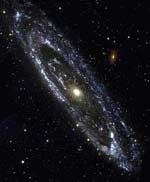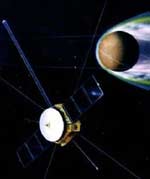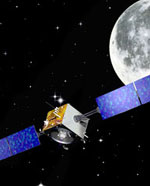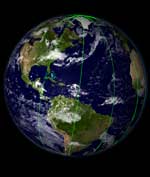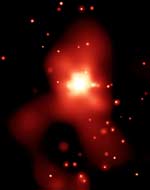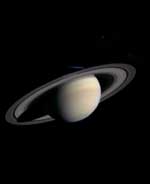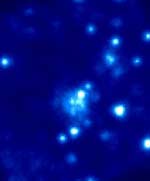
Image credit: ESA
It was only a few years ago that astronomers shook up current models of the Universe with the theory of dark energy; which says that the expansion of the Universe is actually accelerating. But new evidence gathered by the ESA’s XMM-Newton X-ray observatory has cast some doubt on the theory. By looking at distant galaxy clusters – up to 10 billion light-years away – the ESA astronomers found they contained more concentrated matter than the theory of dark energy would predict. If matter was so concentrated, the Universe can’t be 70% dark energy.
ESA’s X-ray observatory, XMM-Newton, has returned tantalising new data about the nature of the Universe. In a survey of distant clusters of galaxies, XMM-Newton has found puzzling differences between today’s clusters of galaxies and those present in the Universe around seven thousand million years ago. Some scientists claim that this can be interpreted to mean that the ‘dark energy’ which most astronomers now believe dominates the Universe simply does not exist?
Observations of eight distant clusters of galaxies, the furthest of which is around 10 thousand million light years away, were studied by an international group of astronomers led by David Lumb of ESA’s Space Research and Technology Centre (ESTEC) in the Netherlands. They compared these clusters to those found in the nearby Universe. This study was conducted as part of the larger XMM-Newton Omega Project, which investigates the density of matter in the Universe under the lead of Jim Bartlett of the College de France.
Clusters of galaxies are prodigious emitters of X-rays because they contain a large quantity of high-temperature gas. This gas surrounds galaxies in the same way as steam surrounds people in a sauna. By measuring the quantity and energy of X-rays from a cluster, astronomers can work out both the temperature of the cluster gas and also the mass of the cluster.
Theoretically, in a Universe where the density of matter is high, clusters of galaxies would continue to grow with time and so, on average, should contain more mass now than in the past.
Most astronomers believe that we live in a low-density Universe in which a mysterious substance known as ‘dark energy’ accounts for 70% of the content of the cosmos and, therefore, pervades everything. In this scenario, clusters of galaxies should stop growing early in the history of the Universe and look virtually indistinguishable from those of today.
In a paper soon to be published by the European journal Astronomy and Astrophysics, astronomers from the XMM-Newton Omega Project present results showing that clusters of galaxies in the distant Universe are not like those of today. They seem to give out more X-rays than today. So clearly, clusters of galaxies have changed their appearance with time.
In an accompanying paper, Alain Blanchard of the Laboratoire d’Astrophysique de l’Observatoire Midi-Pyr?n?es and his team use the results to calculate how the abundance of galaxy clusters changes with time. Blanchard says, “There were fewer galaxy clusters in the past.”
Such a result indicates that the Universe must be a high-density environment, in clear contradiction to the ‘concordance model,’ which postulates a Universe with up to 70% dark energy and a very low density of matter. Blanchard knows that this conclusion will be highly controversial, saying, “To account for these results you have to have a lot of matter in the Universe and that leaves little room for dark energy.”
To reconcile the new XMM-Newton observations with the concordance models, astronomers would have to admit a fundamental gap in their knowledge about the behaviour of the clusters and, possibly, of the galaxies within them. For instance, galaxies in the faraway clusters would have to be injecting more energy into their surrounding gas than is currently understood. That process should then gradually taper off as the cluster and the galaxies within it grow older.
No matter which way the results are interpreted, XMM-Newton has given astronomers a new insight into the Universe and a new mystery to puzzle over. As for the possibility that the XMM-Newton results are simply wrong, they are in the process of being confirmed by other X-ray observations. Should these return the same answer, we might have to rethink our understanding of the Universe.
The contents of the Universe
The content of the Universe is widely thought to consist of three types of substance: normal matter, dark matter and dark energy. Normal matter consists of the atoms that make up stars, planets, human beings and every other visible object in the Universe. As humbling as it sounds, normal matter almost certainly accounts for a small proportion of the Universe, somewhere between 1% and 10%.
The more astronomers observed the Universe, the more matter they needed to find to explain it all. This matter could not be made of normal atoms, however, otherwise there would be more stars and galaxies to be seen. Instead, they coined the term dark matter for this peculiar substance precisely because it escapes our detection. At the same time, physicists trying to further the understanding of the forces of nature were starting to believe that new and exotic particles of matter must be abundant in the Universe. These would hardly ever interact with normal matter and many now believe that these particles are the dark matter. At the present time, even though many experiments are underway to detect dark matter particles, none have been successful. Nevertheless, astronomers still believe that somewhere between 30% and 99% of the Universe may consist of dark matter.
Dark energy is the latest addition to the contents of the Universe. Originally, Albert Einstein introduced the idea of an all-pervading ‘cosmic energy’ before he knew that the Universe is expanding. The expanding Universe did not need a ‘cosmological constant’ as Einstein had called his energy. However, in the 1990s observations of exploding stars in the distant Universe suggested that the Universe was not just expanding but accelerating as well. The only way to explain this was to reintroduce Einstein’s cosmic energy in a slightly altered form, called dark energy. No one knows what the dark energy might be.
In the currently popular ‘concordance model’ of the Universe, 70% of the cosmos is thought to be dark energy, 25% dark matter and 5% normal matter.
Original Source: ESA News Release

